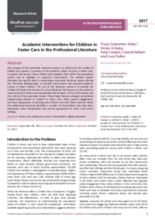Displaying 1781 - 1790 of 2496
This study investigated social capital, risk factors, and protective factors associated with the likelihood that youth in foster care will enroll in college.
In this video from the BBC two women from the US, tell their stories of being married as children.
This study contributes to the literature by examining risk and protective factors of chronic neglect.
This report provides preliminary estimates of Adoption and Foster Care Analysis and Reporting System (AFCARS) data for FY 2016 in the United States.
The authors of this article performed a multiple case study to gather information about barriers and facilitators in building a working alliance between social workers and families.
The authors used a mixed-methods, cross-sectional design, focused on qualitative results to explore how foster parents in the US utilize daily routines in foster care.
This podcast gives listeners an overview of how Arizona Kinship Support Services implements the Family Group Conference (FGC) model.
The purpose of this systematic literature review is to determine the number of articles and provide a summary of the academic needs of youth in foster care, to explore the barriers those children and caregivers face within the educational system and to highlight to successful interventions.
An American couple adopted their baby by posting an advertisement on Craigslist.
The Canadian government has reached a major settlement with indigenous victims forcibly removed from their homes and placed in state care as children.


